Stars Less Strange: An Analysis of Fanfiction and Representation within the Tolkien Fan Community by Dawn Walls-Thumma
Posted on 27 July 2021; updated on 28 July 2021
This paper was previously presented at the Tolkien Society Seminar "Tolkien and Diversity" held online on 4 July 2021.
Watch a recording of "Stars Less Strange" on the Tolkien Society YouTube channel.
Today I'd like to consider fanfiction about Tolkien's world, the history of this vast community, and how it has used--and not used--storytelling to address issues of representation and diversity in Middle-earth. To begin, what is fanfiction? I could devote a 20-minute paper to the finer points of the debate around the definition of a term that, for most of us, can probably be summed up along the lines of Justice Potter Stewart's definition of pornography: You know it when you see it. For my purposes, I will consider fanfiction as any fictional work that draws elements from an existing literary, media, or other text. Furthermore, fanfiction writers do not receive monetary compensation for their work, distinguishing them culturally from the producers of big-budget adaptations--Peter Jackson and company are the most salient example in this case--even if their creative processes look remarkably the same.
When I say that fanfiction writers and the writers of sanctioned adaptations differ culturally from one another, I begin to get to the heart of my paper today. Sanctioned adaptations, such as the Peter Jackson film trilogies, tend to retain and even amplify racist and sexist aspects of the legendarium. A generation of fans once free to imagine Orcs however they please, for example, now assume they are dark-skinned and dreadlocked. Women characters in heroic roles--some of them canonical (Éowyn), others elevated (Arwen), and others invented entirely (Tauriel)--still find their romantic interests centered in a way that they are not for characters like Aragorn. And queer characters remain entirely absent.
For decades now, fan studies scholars have asserted that fanfiction is different. Unbeholden to powerful economic interests that benefit from maintaining the status quo, fanfiction writers have the potential to transform texts to make room for typically marginalized voices. Fan studies scholars, overall, would assert this as a if not the primary purpose of fanfiction. For example, in a 2006 article, Abigail Derecho termed fanfiction the "literature of the subordinate" for its potential to open texts to perspectives and voices excluded by publishing and media industries that have only recently and feebly begun to stir toward realizing that a tiny minority of the world's population--cisgender, straight, white males--does not in fact hold all of the good stories. Tolkien scholar Una McCormick, speaking specifically of Tolkien-based fanfiction, made a similar assertion with her idea of "reparative reading": that fans who do not see themselves in the stories can use fanfiction to expand the legendarium to include more diverse perspectives. For anyone interested in more diverse stories, the possibilities represented by fanfiction become enormous and exciting.
Before I begin, I want to define a fanfiction term I'm going to use a lot: canon. By this, we don't mean the artistic works that lie at the foundation of a culture but the set of facts about a secondary world--in this case, Arda--that are accepted by the majority of fans as true of that world. While fanfiction communities vary in the importance they place on the canon, Tolkien fanfiction communities tend to highly value knowledge of the canon. Because Tolkien's canon is far from straightforward, details and interpretations enshrined by fans as canon often reveal whose perspectives are privileged in the stories created by a particular community.
History of Tolkien Fanfiction Fandom
Fanfiction about Tolkien's legendarium has existed at least since 1957, and in the age of online fanfiction, has become one of the largest, most prolific fandoms. Due to its prodigious size and longevity, therefore, I want to offer the reminder that I cannot speak for every Tolkien fanfiction community, much less every Tolkien fanfiction writer, that has existed across the vast breadth and depth of its history. At its peak in the early 2000s, there were hundreds of Tolkien fanfiction groups, some with thousands of members and others with just a few. It is impossible to represent the values and practices of them all.
For this presentation, I have gathered information using two approaches. First is that of a historian. Some of the early Tolkien fanfiction groups are still online; others have been archived by fandom historians over the years. I've gone back to those groups to see how members discussed gender, race, and sexuality. To capture a more contemporary perspective, I use results from the Tolkien Fanfiction Survey, open to all writers and readers of Tolkien-based fanfiction, which I ran first in 2015 and again in 2020 in collaboration with Maria Alberto.
So to return to the question at the heart of my presentation today: Do Tolkien fanfiction writers use their craft to foreground the perspectives and experiences of marginalized groups? Tolkien's legendarium--at least in terms of mainstream readings to this point--reflects much of Western literature and media in either excluding these perspectives, such as the lack of women characters, or relegating members of a group to a stereotyped or caricatured role, such as an overreliance on dark-skinned villains. There is a similar lack of queer and working-class characters. As Una McCormack discussed in her essay on reparative reading, fanfiction writers can address these shortcomings in several ways. First is to invent original characters belonging to marginalized groups to coexist alongside characters from the canon. Secondly, fanfiction writers can develop minor characters who belong to (or could belong to) a marginalized group. Finally, fanfiction writers can take a character who has a major role and center his or her perspective as a member of a marginalized group--for example, focusing on Éowyn's experiences as a woman fighting in a war or Samwise Gamgee's perspective as the sole working-class member of the Fellowship.
Historically, Tolkien fanfiction has undertaken this work most often for two groups of characters: women and queer characters. In both cases, the reaction of the wider fanfiction community has shown this to be a fraught endeavor, with responses often outsized and mirroring the oppressive backlash faced by real-world members of those groups. Following the release of Peter Jackson's Lord of the Rings films, interest in Tolkien-based fanfiction exploded on the Internet. One particular genre was so popular that it was given its own name: the Tenth Walker story. In these stories, a highly idealized girl or young woman, often based on the author and called a self-insert, joined the Fellowship on their quest. She typically attracted the romantic interest of at least one of the book characters, and this is where the story often focused. Authors of Tenth Walker stories were typically teen girls.
Taking in a wider view of Western storytelling, none of this is terribly radical. After all, the idea of an ordinary (even underwhelming) boy or man discovering that he has exceptional talents and using them, in many cases, to literally save the world is a common trope in stories that have commanded the adoration of millions of fans, such as Spiderman and Harry Potter. Nor are self-inserts inherently a byword in fiction. Many male authors write self-inserts to great acclaim. Tolkien himself wrote one. Finally, as a teacher who works with young adolescents, this is an age where young people become alive to the full breadth and possibilities in the world around them while not yet fully cognizant of its limitations--limitations too often prescribed by the demographic group they belong to. In other words, kids at this age dream big. Therefore, there was nothing culturally or developmentally unusual about the Tenth Walker phenomenon, in young women writers responding to a text they loved by making room to see themselves as characters with enough agency to shape the story.
One would not have known it from the reaction of the broader Tolkien fanfiction community. Here, I want to give fair warning that I will be discussing threats of violence, suicide, and self-harm, often directed toward adolescents. If you're not up for this kind of content today, check back with me in about two minutes. Responses to these young women's stories were vicious and came both from fans acting individually as well as part of organized campaigns. One such organization, called Protectors of the Plot Continuum or PPC--which still exists today--originated with the primary intention to mock authors of so-called "Mary Sue" stories, a term I'll discuss more in a moment and that includes Tenth Walkers. The quotes on the screen from the PPC's website show how their responses to these stories were presented in explicitly violent terms.While the PPC mocked many genres of story, the section of their website devoted to Mary Sue stories is the only section that uses this kind of violent language, and while the PPC asserts the fictionalization of their violent acts, it is significant that Mary Sues are a genre where the author is the character targeted--and the female author at that. While the PPC "merely" mocked stories, other fans went further, and sometimes threatened writers of Tenth Walker or Mary Sue stories with harm and encouraged them to commit suicide. Again, recall that not only were these authors mostly children, mostly girls, but their youth was often held up as a rationale for attacking their stories, for the apparently grave offense of daring to place themselves inside a beloved literary work.
Similar was the Mary Sue phenomenon. Mary Sue is a generally derogatory term that originated in Star Trek fandom for an idealized original female character who exerted enough influence to reshape the plot or cause characters to behave out-of-character. In the early online Tolkien fanfiction community, the use of the term Mary Sue is interesting because of how it umbrellaed very quickly until it encompassed nearly any story that involved an original female character. The presence of an original female character alone--no matter how well-written--could earn disapprobation as a Mary Sue. In reading back through message archives for Tolkien fanfiction groups in the early-mid 2000s, I encountered anxiety from authors who wanted to write more women in their stories but feared receiving the dreaded label of Mary Sue. Authors who did write women often took extra care to steer their characterization away from anything that suggested the traits of a Mary Sue, thus circumscribing the options available to women in their stories, especially options that did allow these women to shape the story.
Another genre similarly subjected to aggressive scrutiny and attack in the early online fandom was slash, a genre of fanfiction where two same-sex characters are paired together romantically or sexually. Like Mary Sue, slash has its origins in the Star Trek fandom and was a genre with decades of history before fanfiction migrated online in the early 2000s. Like Mary Sue stories, within the early online Tolkien fanfiction fandom, slash fiction was singled out for censure by other fans. Likewise, the canon was weaponized to conceal essentially homophobic objections within the guise of textual fidelity and respect for Tolkien. While also subjected to harassment--including threats of violence--slash authors were often explicitly excluded from the mainstream fanfiction community. During this era--a time in U.S. history littered with record amounts of legislation excluding LGBTQ+ citizens from full involvement in family and cultural institutions--multiple large Tolkien fanfiction archives banned slash. Because of this, and because slash authors tended to be older than authors of Mary Sue stories, with more resources at their disposal, within the early online Tolkien fanfiction fandom, slash authors tended to form their own communities where they could avoid the harassment they experienced on other sites. The end result of this was a fandom where queer characters--including the very idea that there would have been queer characters in Middle-earth--went unseen by many fans.
In early online Tolkien fanfiction, canon was often wielded against interpretations that allowed for greater representation of diverse perspectives. The sexist underpinnings of the concept of Mary Sue were rarely scrutinized because the genre was criticized under the guise of canonicity, and the result was that many authors feared writing even women who were a canonical presence in the legendarium. The canon also experienced a sort of mission creep. For example, Tolkien's Catholicism, for many fans, became an element of the canon, never mind that no character within the legendarium would have identified as a Catholic. That Catholicism also narrowed to what the most conservative fans believed it to be and allowed no room for Tolkien to maintain a complex perspective beyond his religious beliefs. Thus, queer characters were marked uncanonical, and excluding fanfiction about LGBTQ+ characters became a simple matter of fidelity to the canon and not of homophobia and could not be questioned on those terms. Again and again, what some fans thought Tolkien meant or believed he intended was elevated to the status of canon where it was not open to question and where canonicity became a convenient diversion from discussions of sexism, racism, and homophobia in the fandom.
Once again, it is worth remembering the size and diversity of the Tolkien fanfiction fandom. Certainly, there were communities that encouraged and discussed interpretations of the canon and stories featuring characters representing the full array of human diversity. However, returning to the academic view of fanfiction as a "literature of the subordinate," as transgressive, as radical, as a means to amplify the voices and experiences of marginalized people, we can see that, by and large, in the early online fandom, Tolkien fanfiction's tendency toward a definition of its canon as conservative, in the sense of limiting rather than expanding possible perspectives, foreclosed on many of those opportunities.
Tolkien-Based Fanfiction Today
Which brings us to the fandom as it exists today, two decades after the release of The Fellowship of the Ring in theaters catapulted Tolkien to preeminent status in the early years of online fanfiction. Here, I will turn to data from the Tolkien Fanfiction Survey to gain a sense of how fans writing stories today use those stories--or don't use those stories--to draw forth diverse perspectives.
First of all, who is writing and reading fanfiction about Tolkien's world? In 2020, Maria and I decided to expand out considerably the demographic information that we collected on participants. Some of that data is on the screen now. According to survey data, Tolkien fanfiction is largely written by college-educated young women.
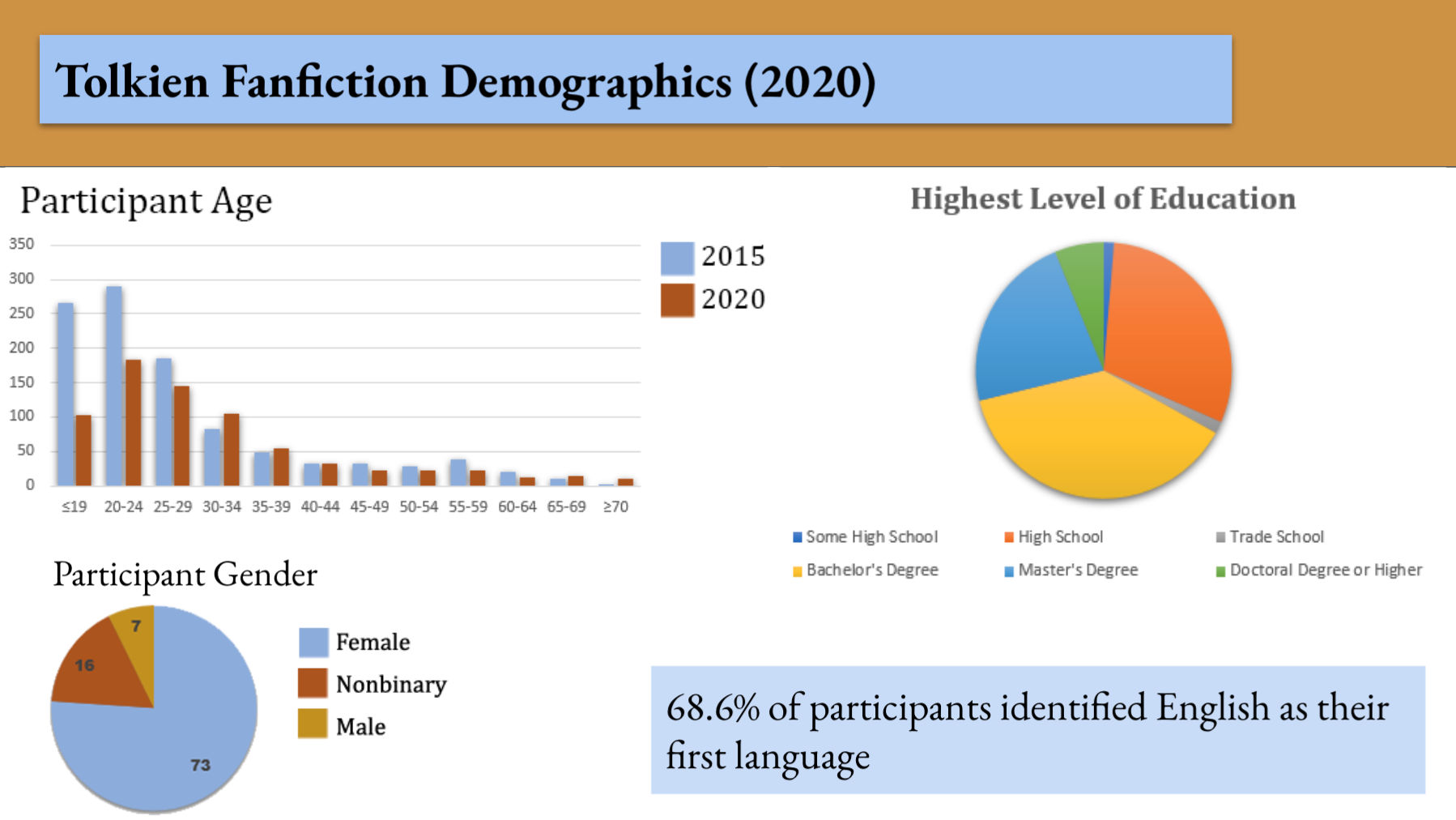
Data on race and ethnicity were entirely up to the participant to define. As Maria and I designed the 2020 survey, including piloting it with other fans, we became increasingly aware of how our own definitions of terms like race and ethnicity were colored by our perceptions as researchers located in the U.S. We ultimately decided, given the diversity of fans within the fanfiction community, to allow participants to self-describe. As a result, data for this item should not be seen as either/or. For example, that 71% of fans included the word white in their response does not mean that 29% of fans are Black, Indigenous, or People of Color. However, as the word cloud shows, Tolkien fanfiction fandom is predominantly White and Western.
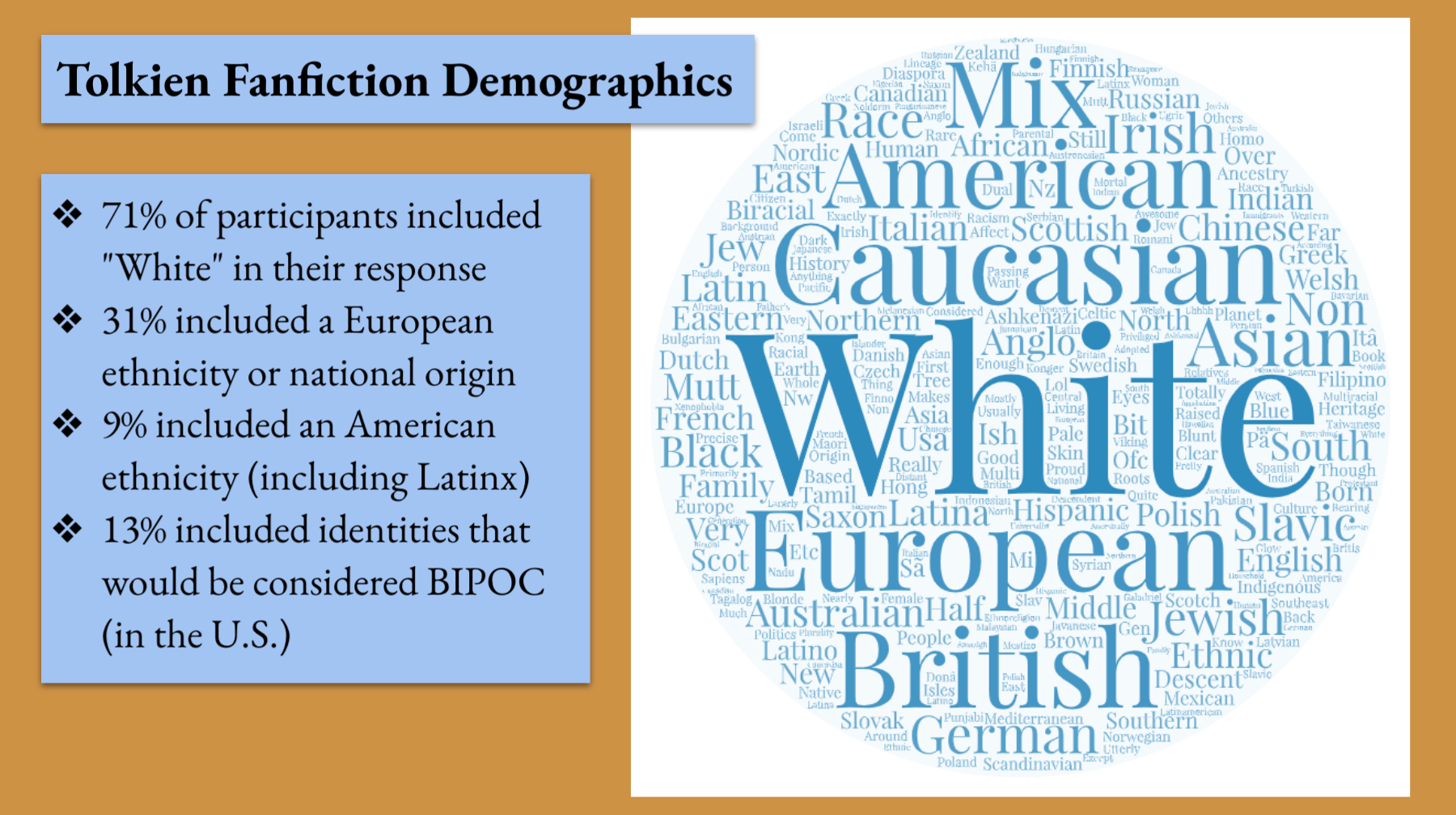
Again, because the fanfiction community is international, U.S. understandings of which identities would be perceived as marginalized did not necessarily hold true. Furthermore, even within the U.S., the experiences of a single identity group are far from monolithic, and we didn't want to assume marginalization--or lack thereof--based on a participant's response to any single item. Therefore, we also allowed participants to identify if and for which identities they felt marginalized. I will also use these data to show how values and behaviors related to fanfiction vary among fans.
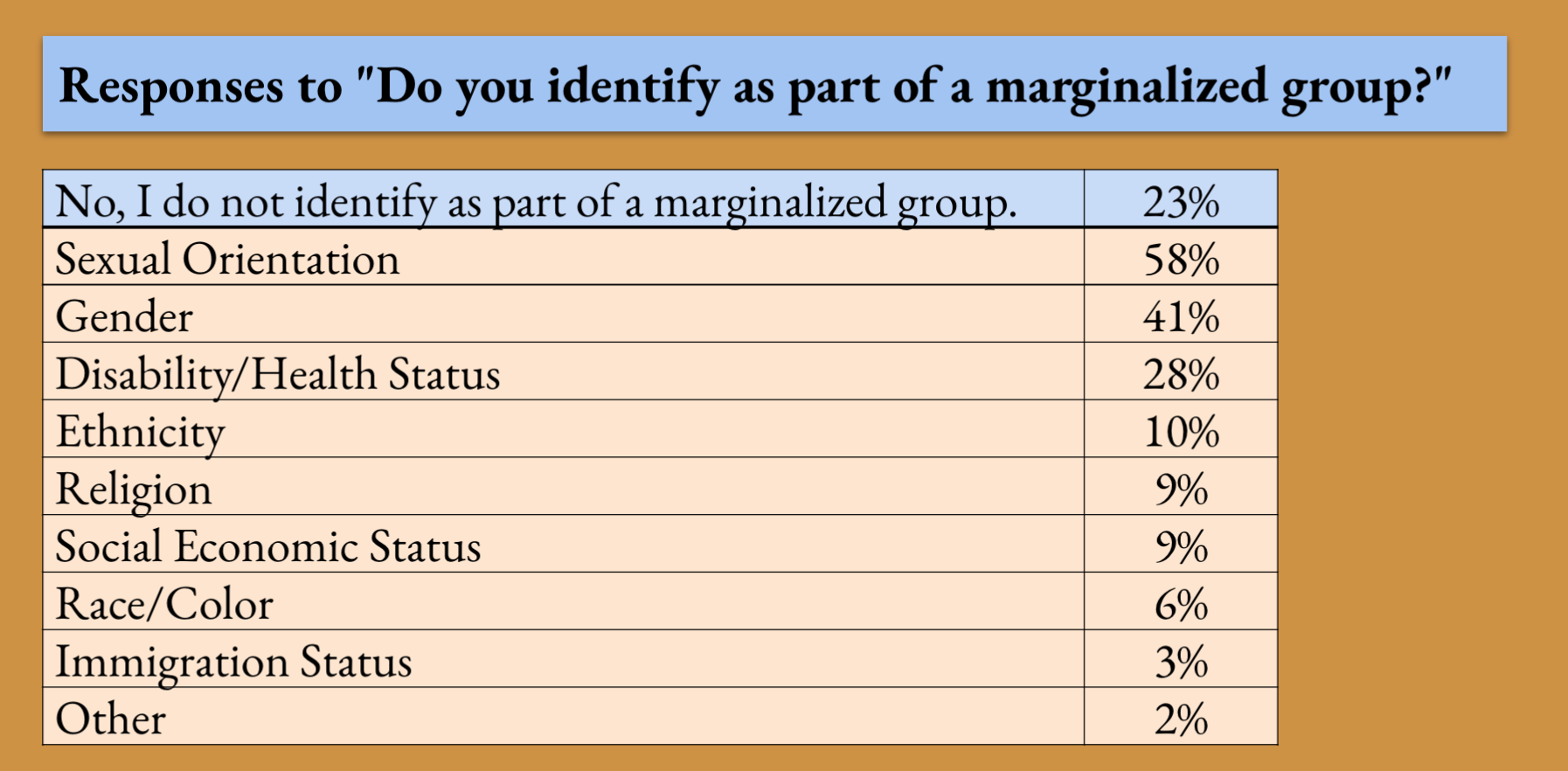
Beginning with those previously maligned female characters, we see that, in both the 2015 and 2020 surveys, authors expressed a high level of interest in using their fanfiction to explore the perspectives of female characters, with 2020 showing a slight bump over the earlier survey.
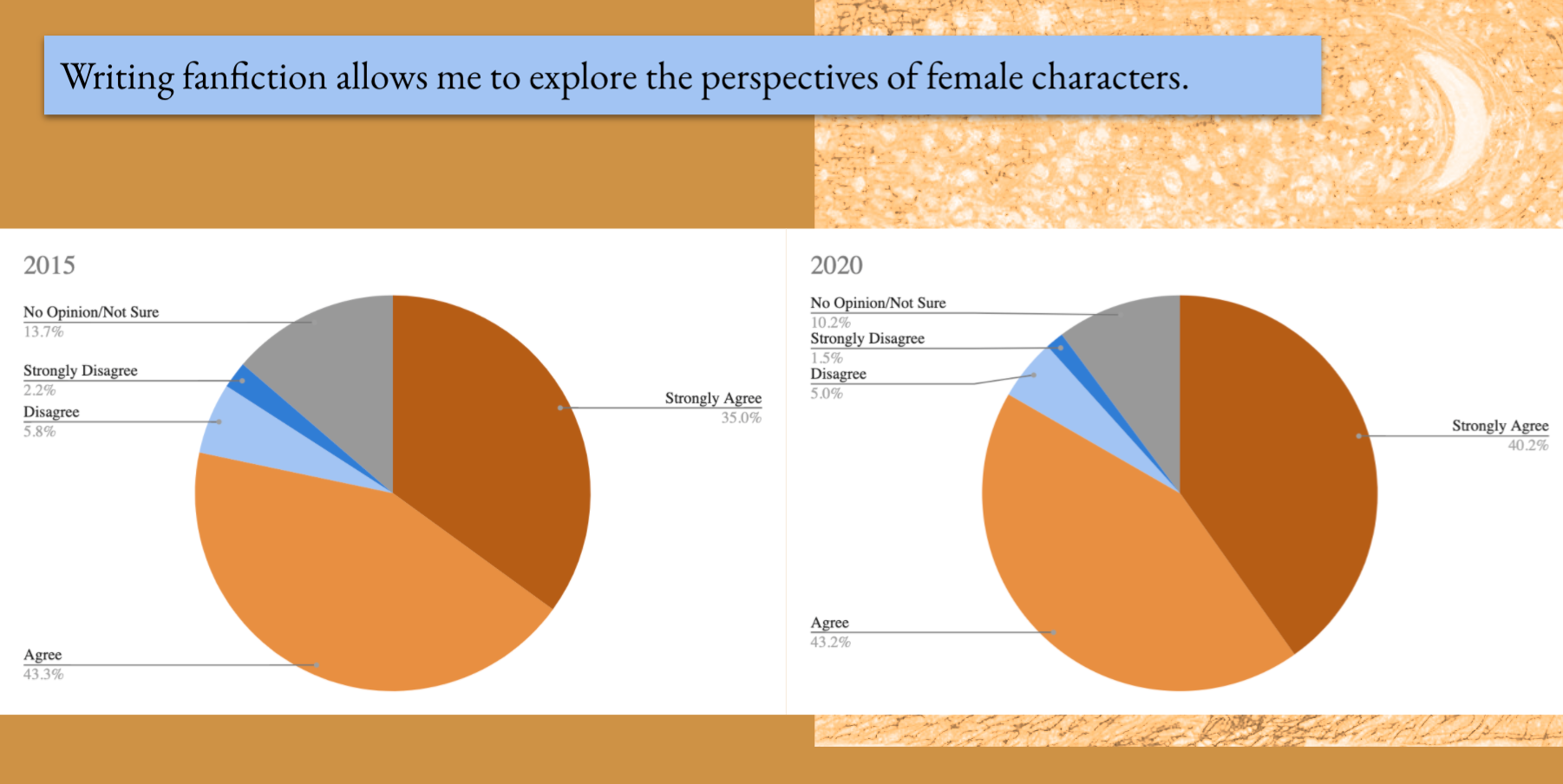
However, while it is one thing to take on the perspectives of diverse characters, to what extent are authors comfortable, firstly, admitting that there are problems with how race, gender, and sexuality are depicted in the legendarium and then going the extra length to use their stories to correct these problems? Here, we see the number of authors drop off quite a bit, though I include two data sets here. The graph on the right shows authors who identified as marginalized based on gender. Among those authors, reparative motives are far more comfortable and common.
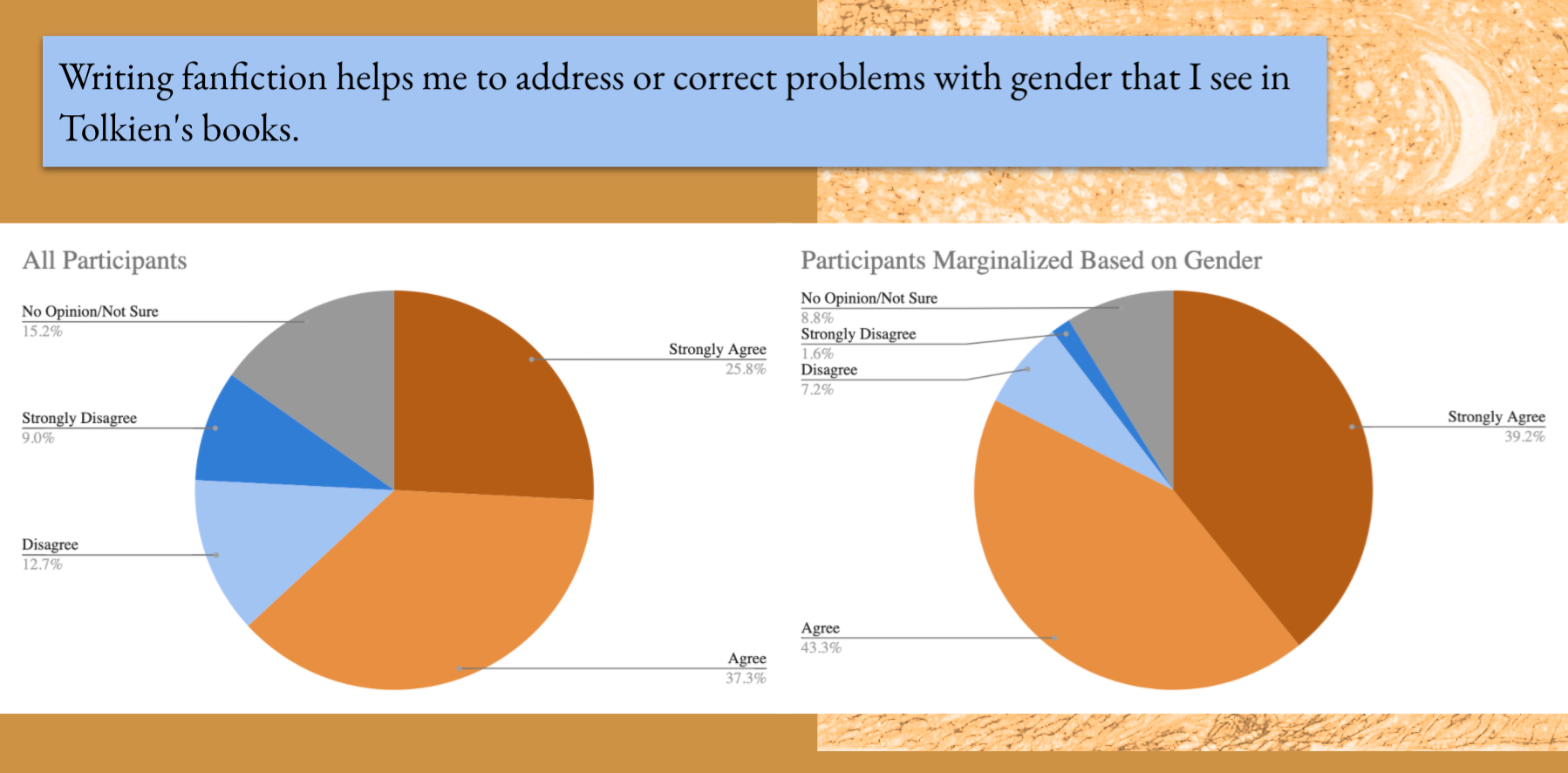
We'll see this pattern emerge again. When asked about using fanfiction to explore the perspectives of LGBTQ+ characters, we see less agreement than the same item about female characters. However, a majority of authors still agreed, and there is the same small bump from 2015 to 2020. When we look at slash authors specifically, not surprisingly, almost all of them agreed with this survey item, which makes sense since they are, by definition, writing about LGBTQ+ characters. But again, among authors who identified as marginalized based on sexual orientation, the number who agreed with this item was significantly higher than for authors in general, suggesting that perception of marginalization motivates creating stories that represent groups in Middle-earth similar to the marginalized groups to which the author belongs.
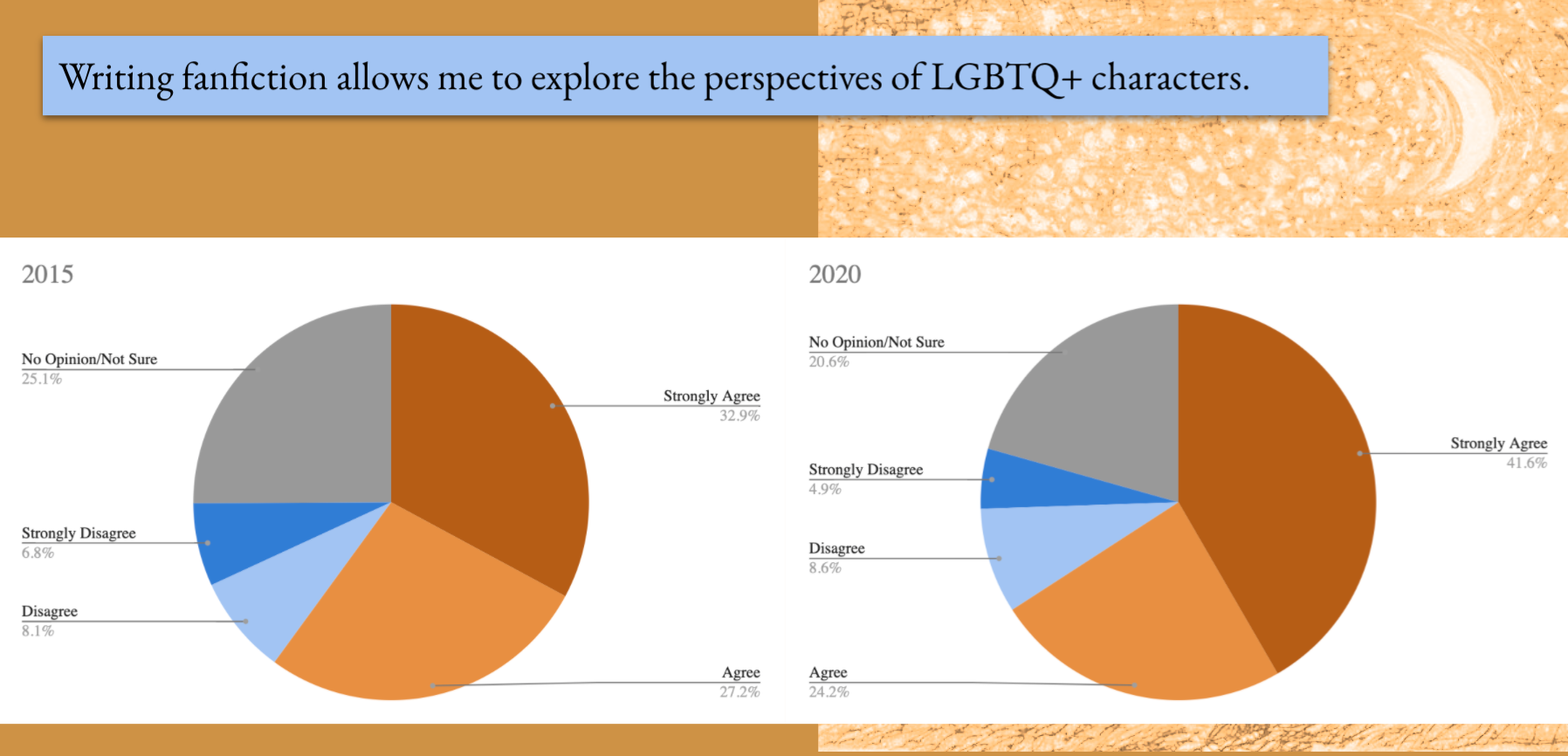
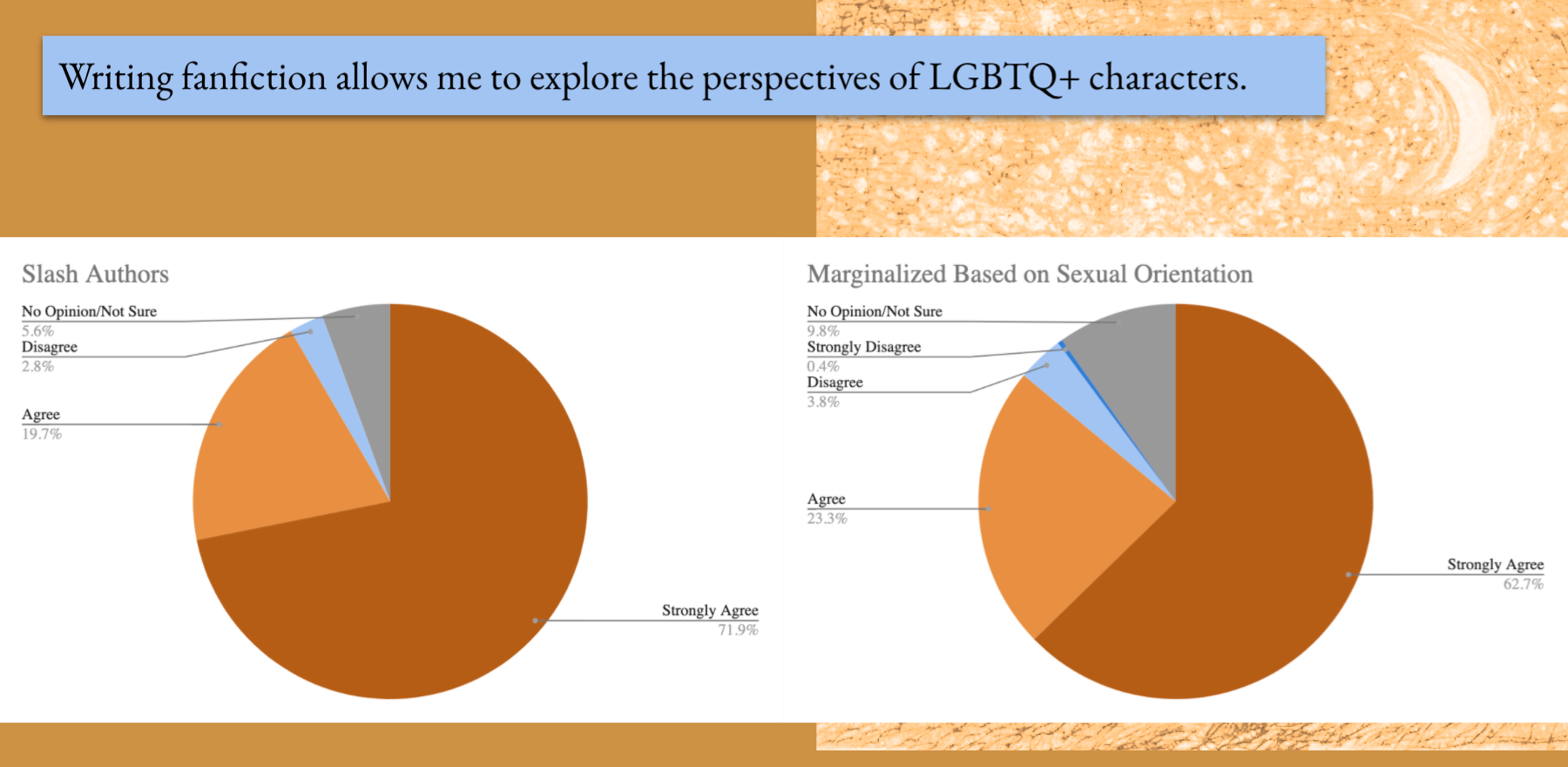
Next, we asked about race. Here, the numbers start to look different, though similar patterns continue to hold across the three categories of questions. Far fewer authors expressed interest in using fanfiction to incorporate the perspectives of characters of color. Returning to the earlier demographic data, this is possibly due to relatively few fans who identify as part of these groups themselves. Only 6% of participants felt marginalized based on race or color compared to 58 and 41% for sexual orientation and gender, respectively.
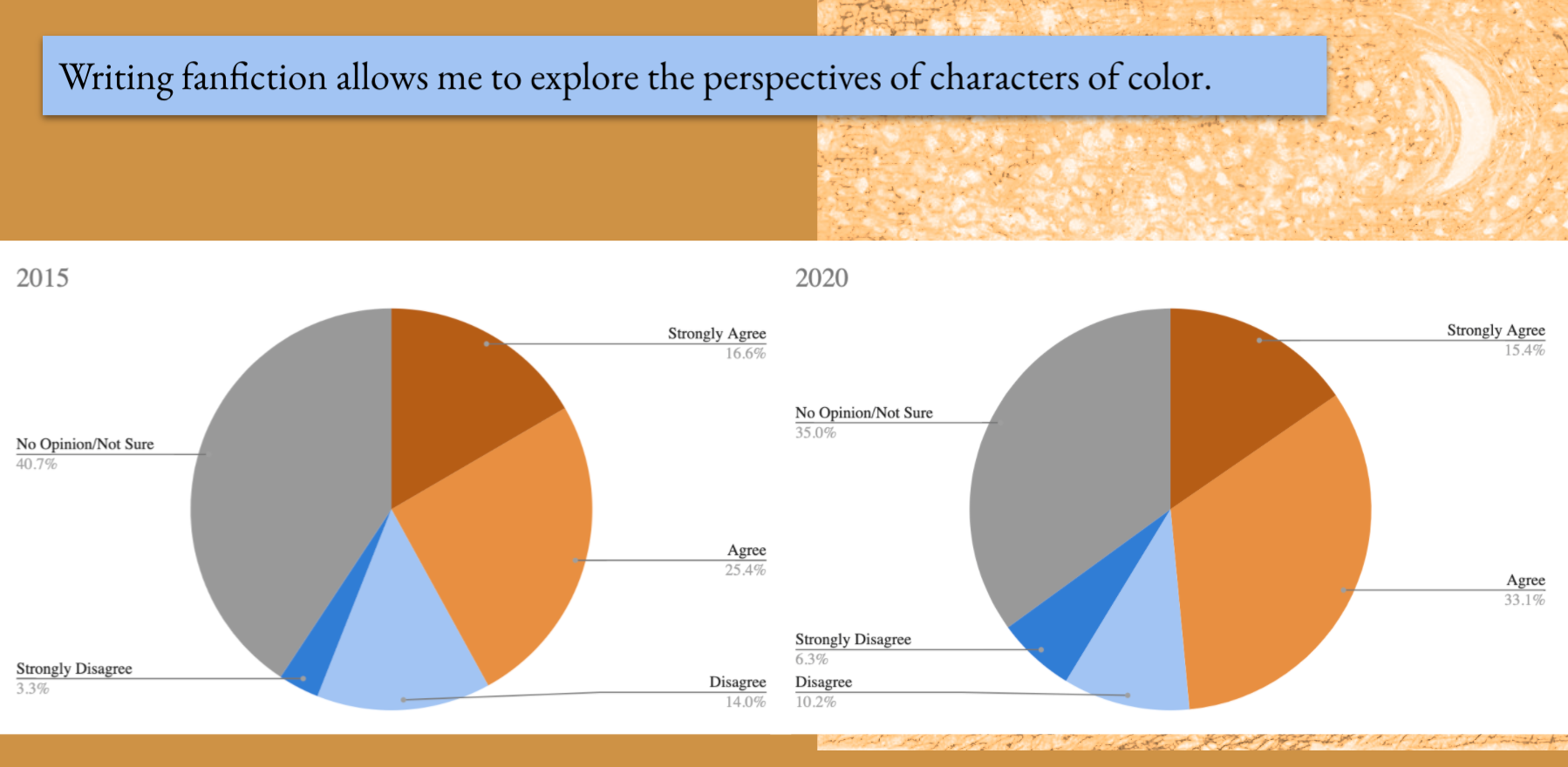
When asked about correcting problems with race, interestingly, more authors agreed than on the question about exploring the perspectives of characters of color. And once again, we see that, among BIPOC authors, this number increases. Among authors who identify as marginalized based on race or color, the number increases yet again until it looks more like the graphs for gender and sexual orientation presented earlier.
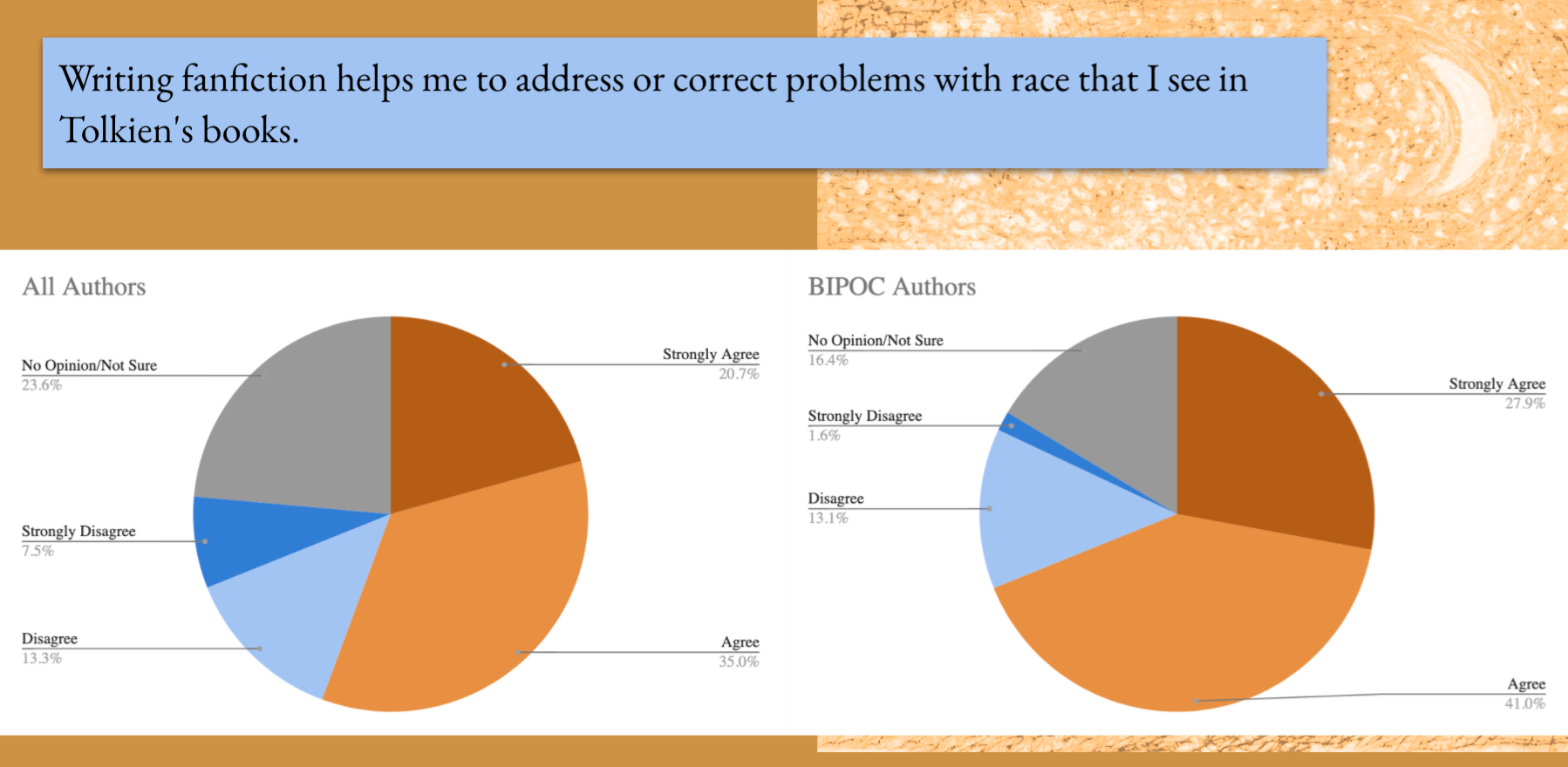
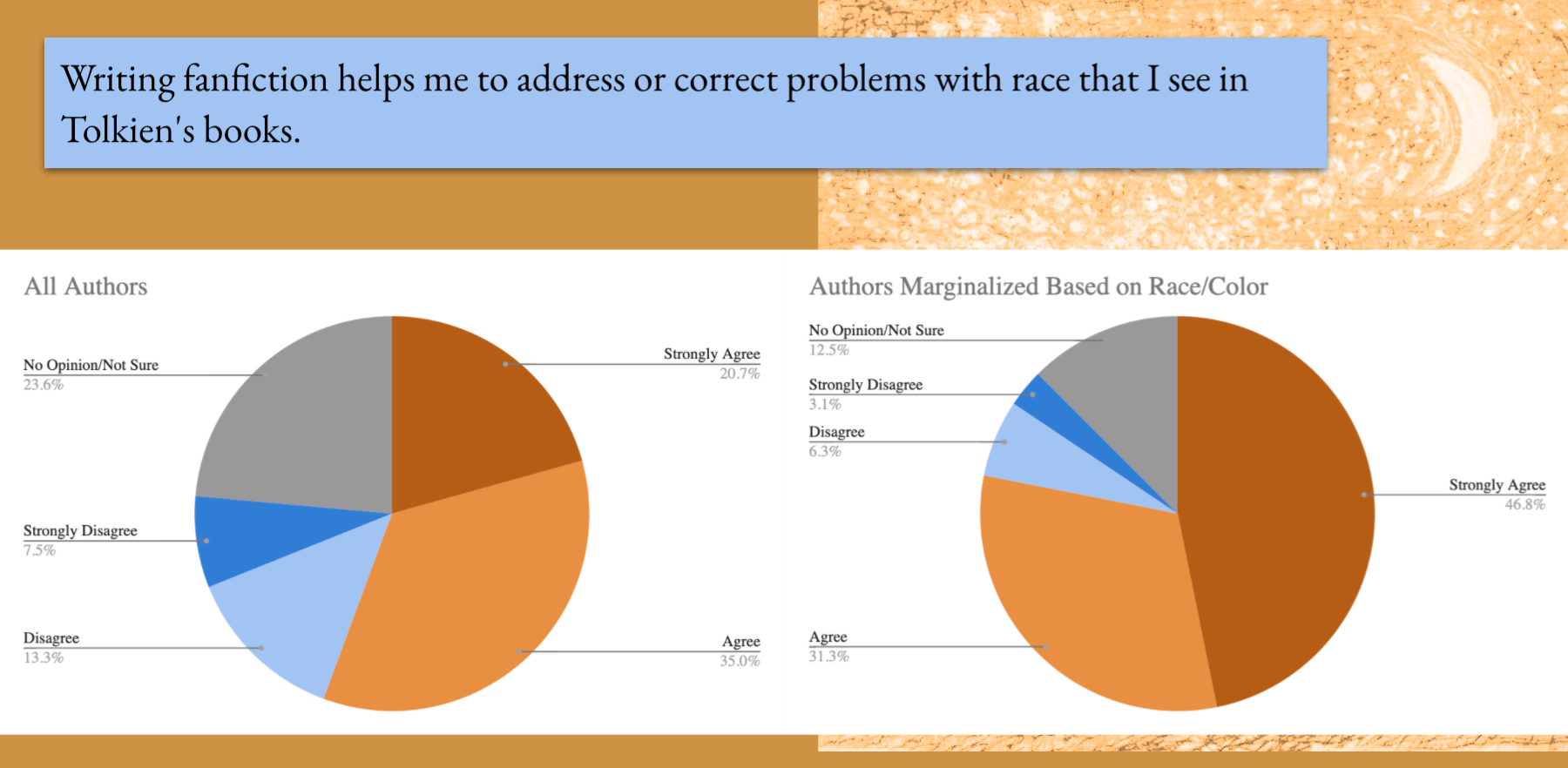
Taken all together, the data suggest that authors often represent the experiences of characters like them, and especially when they identify as part of a marginalized group, they are motivated to not only represent those characters but repair areas where the texts fall short of complex, nonstereotyped depictions of diverse characters.
Furthermore, it is important to consider these data within the fandom's historical context, which was not traditionally friendly to authors wishing to use their stories to expand upon the canon, much less correct it, when the implication is that Tolkien fell short in how he wrote the legendarium. Stories that explored gender and sexuality could have been passed over by readers uninterested in the subject or who felt uncomfortable or disagreed with the implied critique of Tolkien. Instead, the authors of those stories were subjected to the kinds of harassment, including threats of violence, and exclusion that often mirror real-world marginalization of the groups they were writing about. As I noted, canon was weaponized in these situations and used to silence criticism of fans attacking authors who wrote about women or LGBTQ+ characters: Those readers objected to distortion of the canon, not to the presence per se of women or queer characters or characters of color, never mind that their definition of canon foreclosed upon any opportunity for meaningful inclusion of those characters.
But it doesn't have to be this way. Part of Tolkien's genius was that he crafted the legendarium to always invite readers to journey imaginatively beyond the people, places, and perspectives that received his focus. When Aragorn mentions going "where the stars are strange," Tolkien expands his map for readers who wish to see--and see themselves in--those lands. His presentation of his work as historical artifacts invite the reader to imagine those same people and events seen through other eyes. These devices and details are equally canonical--maybe even more so--than those used to exclude diverse fans who imagine the legendarium has room for them--as it does. Survey data shows that Tolkien fanfiction writers still hold an immense regard--almost a reverence--for the canon and often for Tolkien himself. It is through a fuller understanding of what that canon includes--and who it invites into the stories it tells--that has begun to evolve.
Works Cited
Derecho, Abigail. “Archontic Literature: A Definition, a History, and Several Theories of Fan Fiction.” Fan Fiction and Fan Communities in the Age of the Internet, edited by Karen Hellekson and Kristina Busse. McFarland, 2006, pp. 61-78.
McCormack, Una. "Finding Ourselves in the (Un)Mapped Lands: Women's Reparative Readings of The Lord of the Rings." Perilous and Fair: Women in the Works and Life of J.R.R. Tolkien, edited by Janet Brennan Croft and Leslie A. Donovan. Mythopoeic Press, 2015, pp. 309-26.


I appreciate having this…
I appreciate having this data at my fingertips so enormously! Thank you for all your work in collecting and analyzing it.